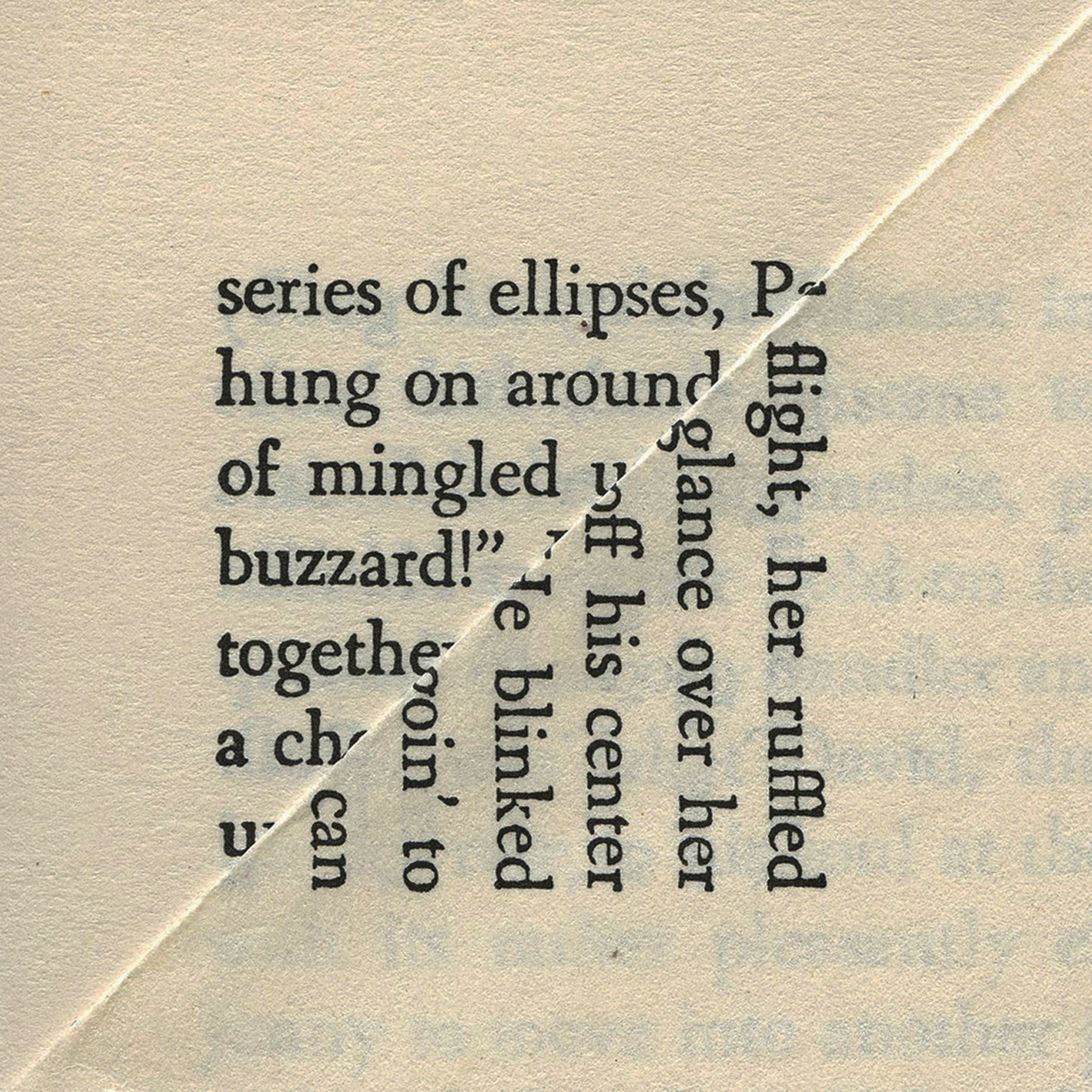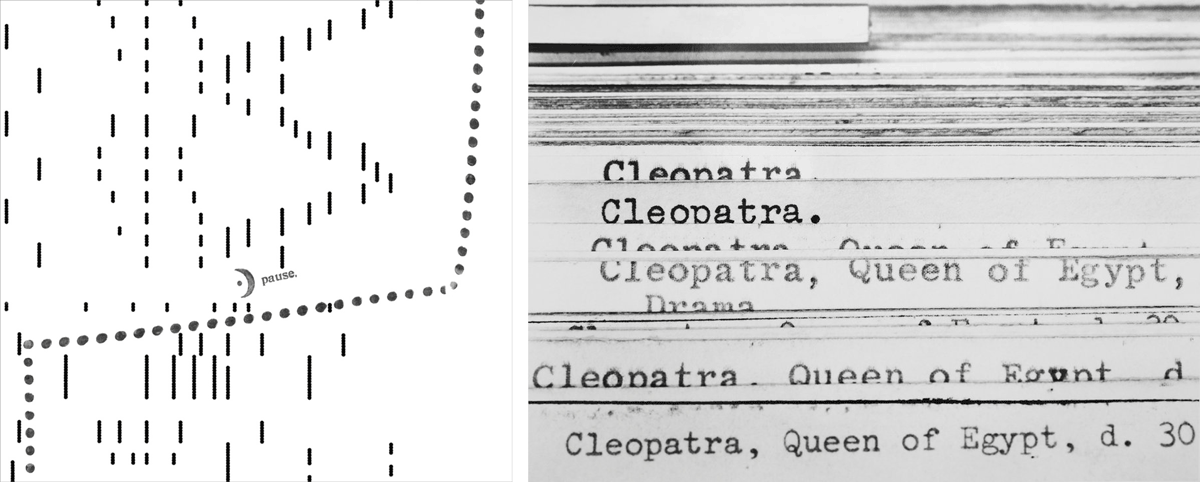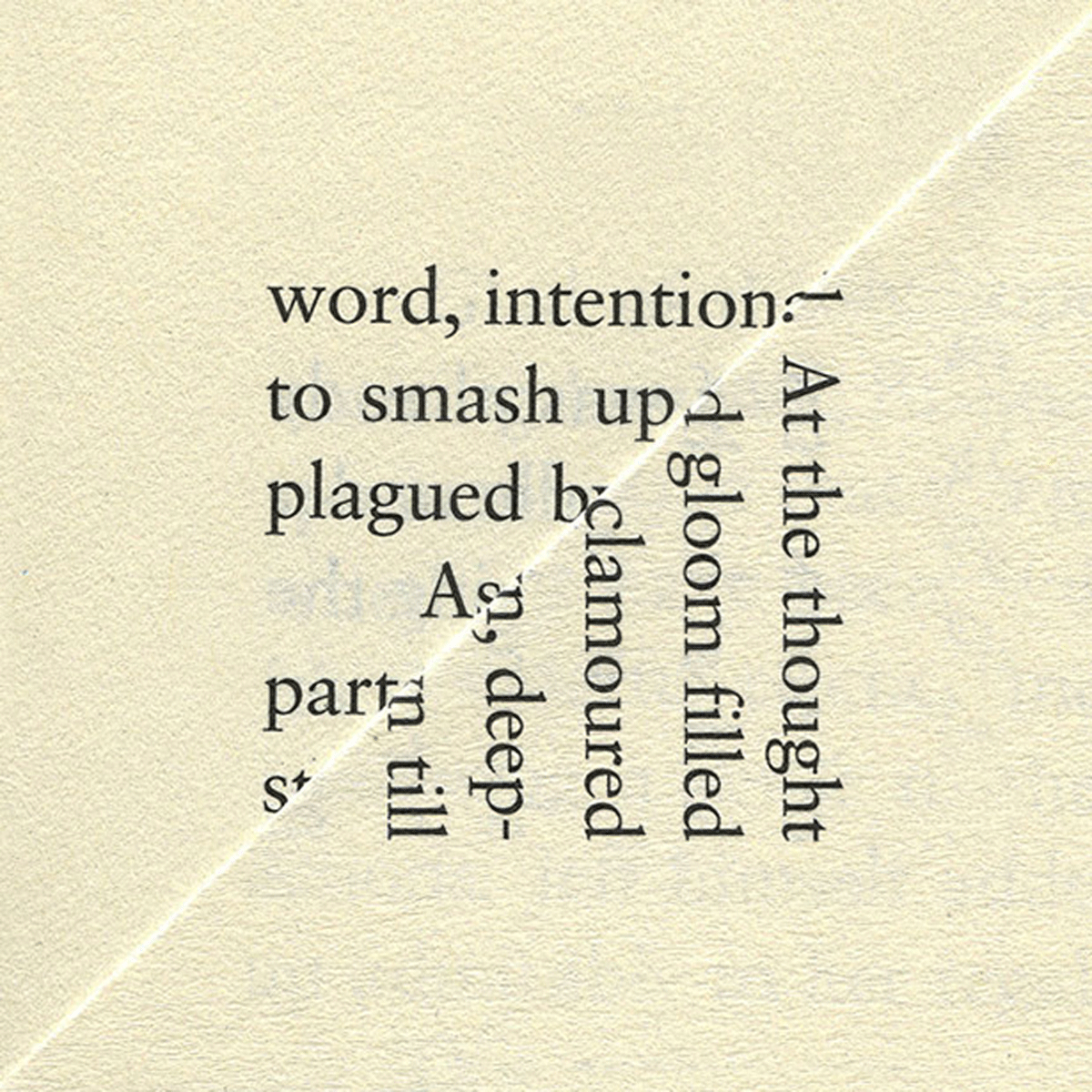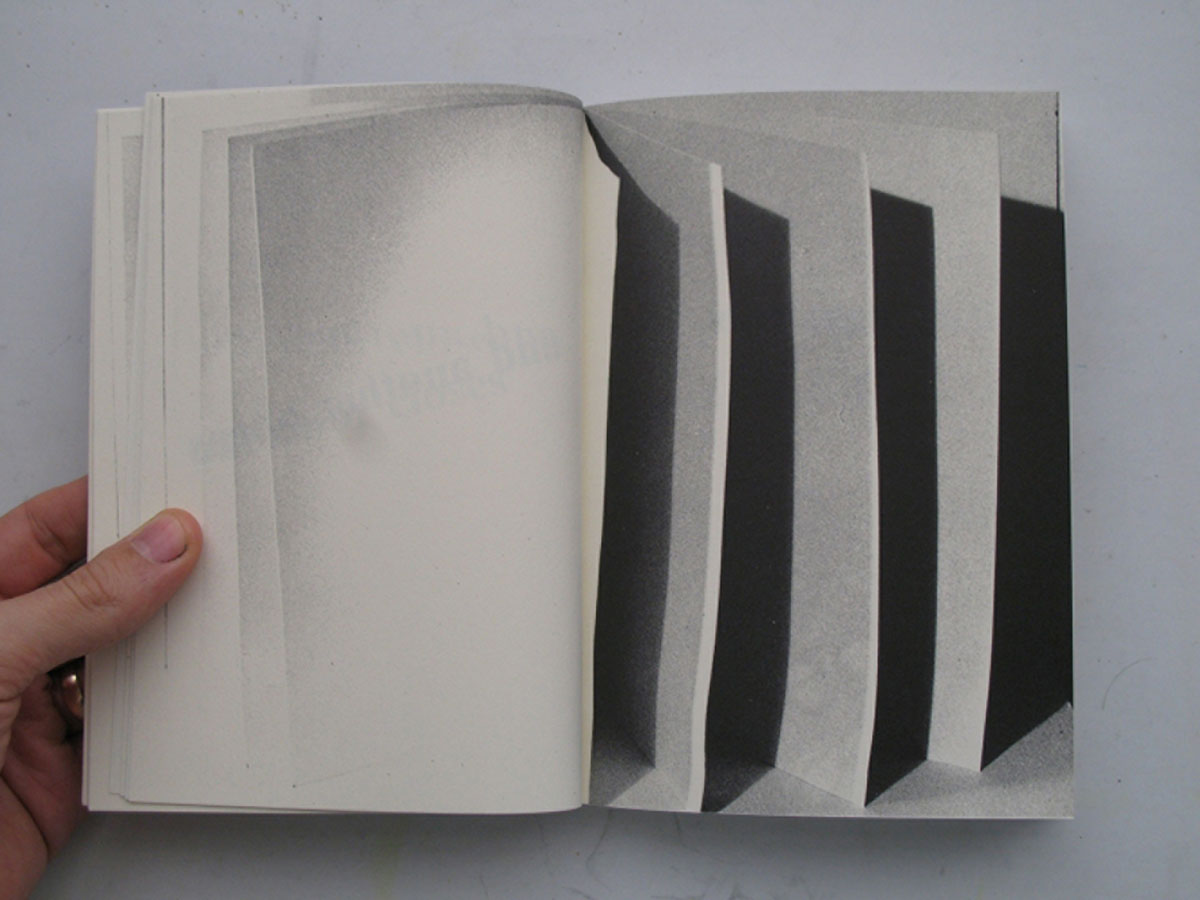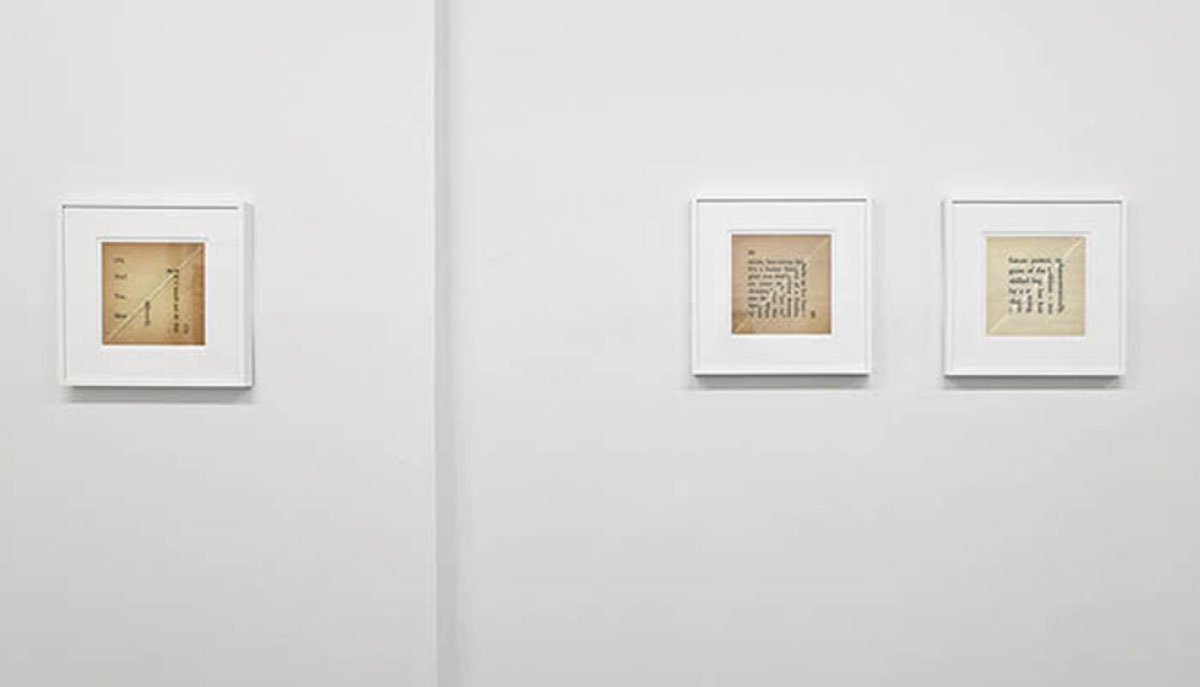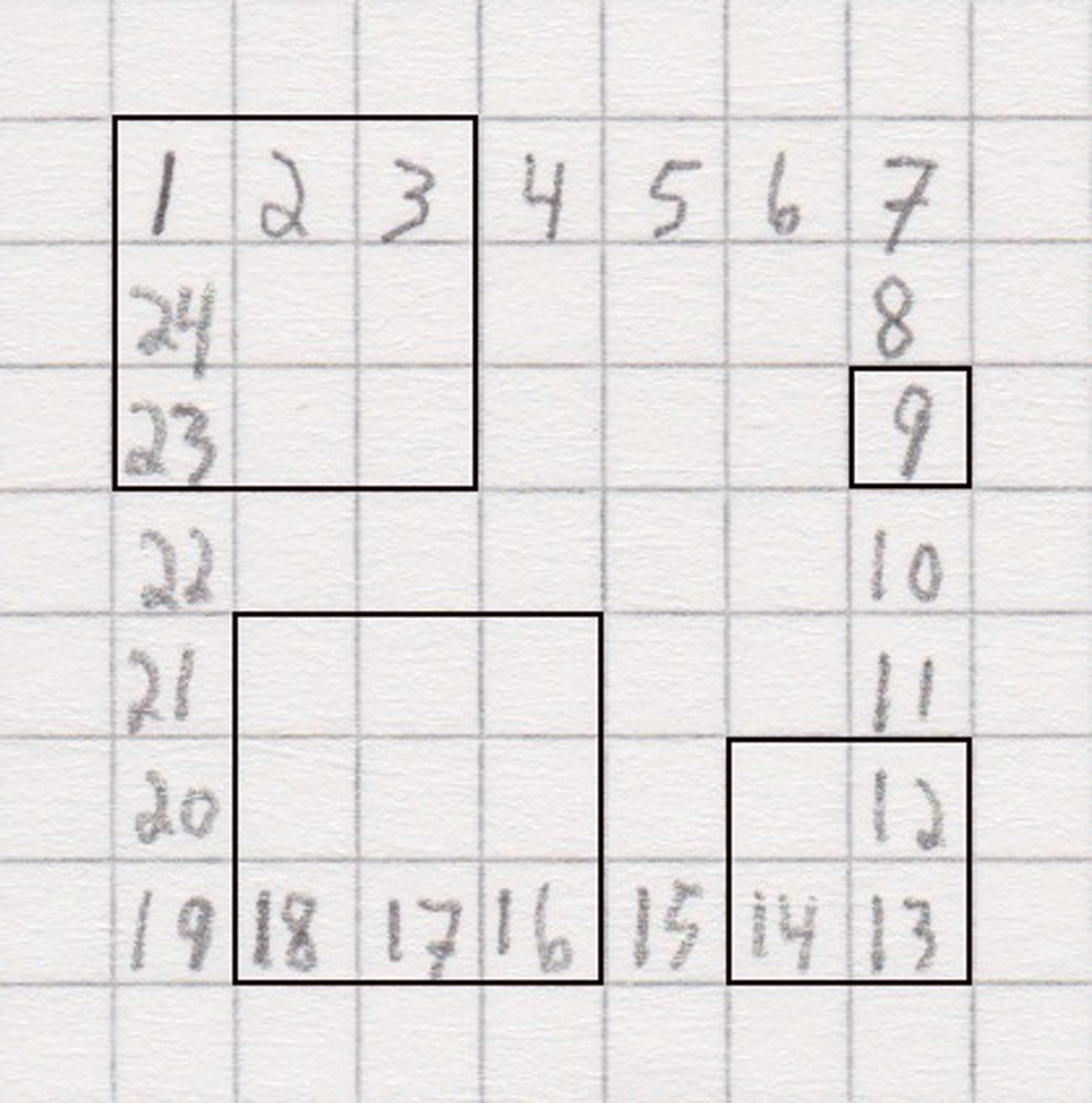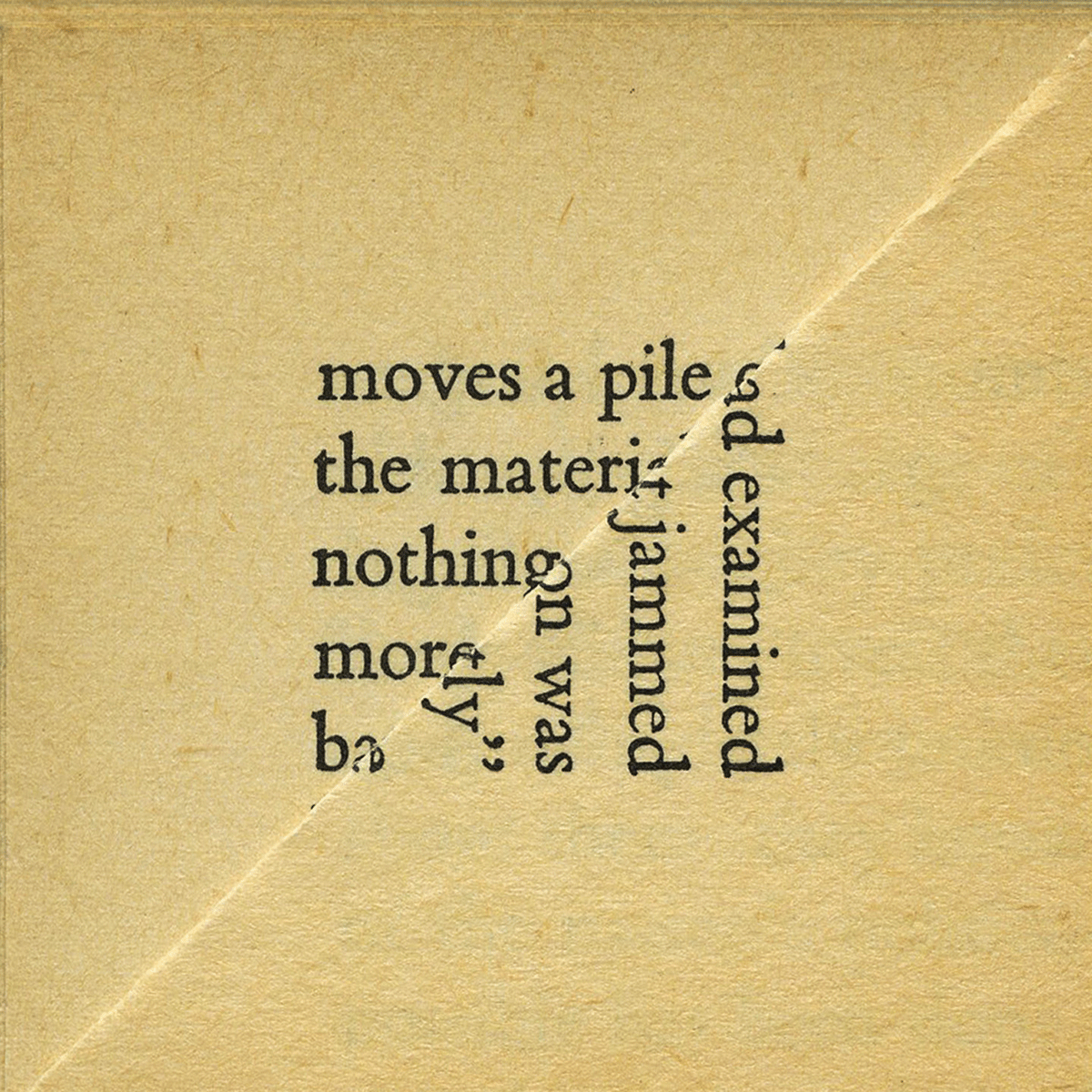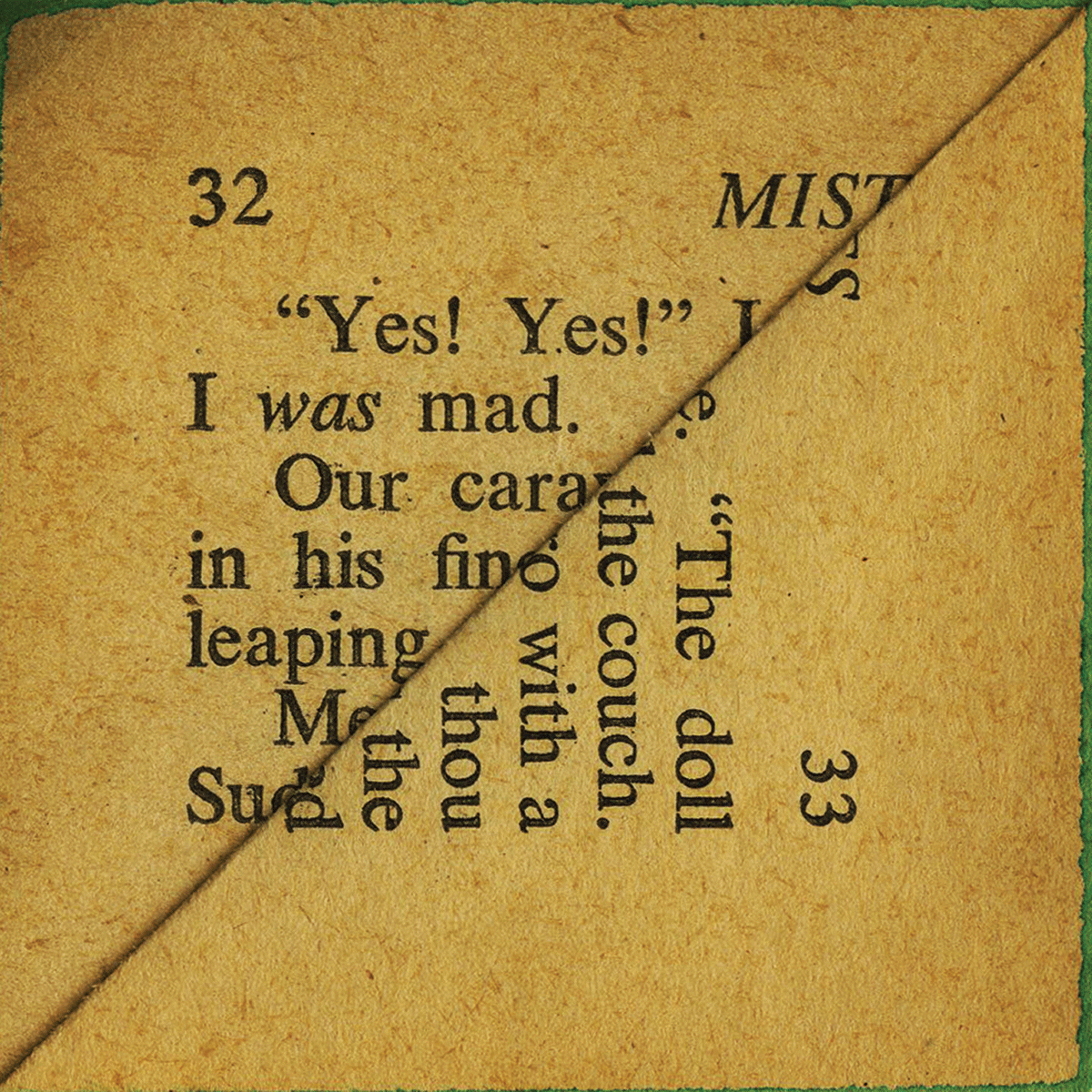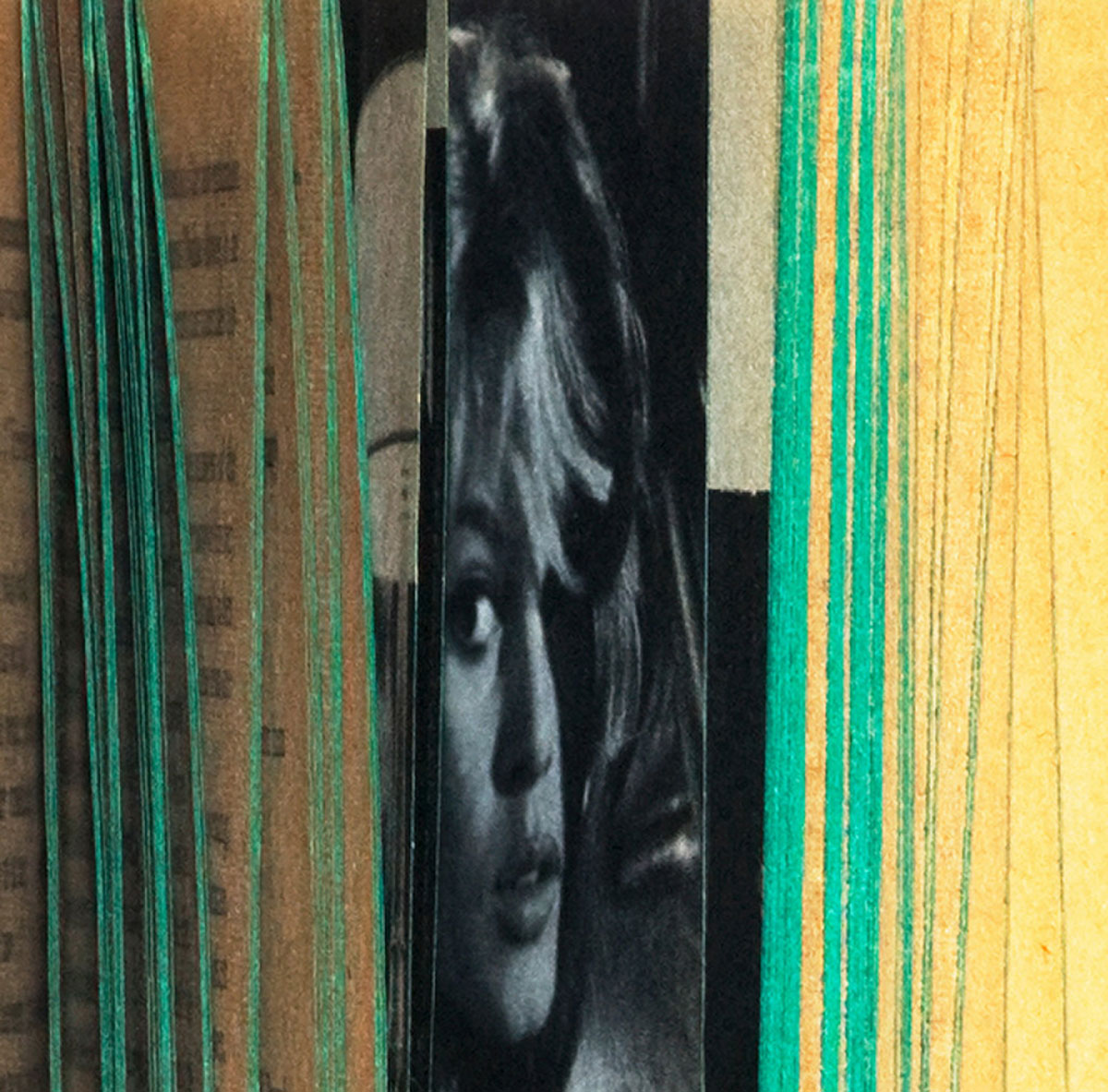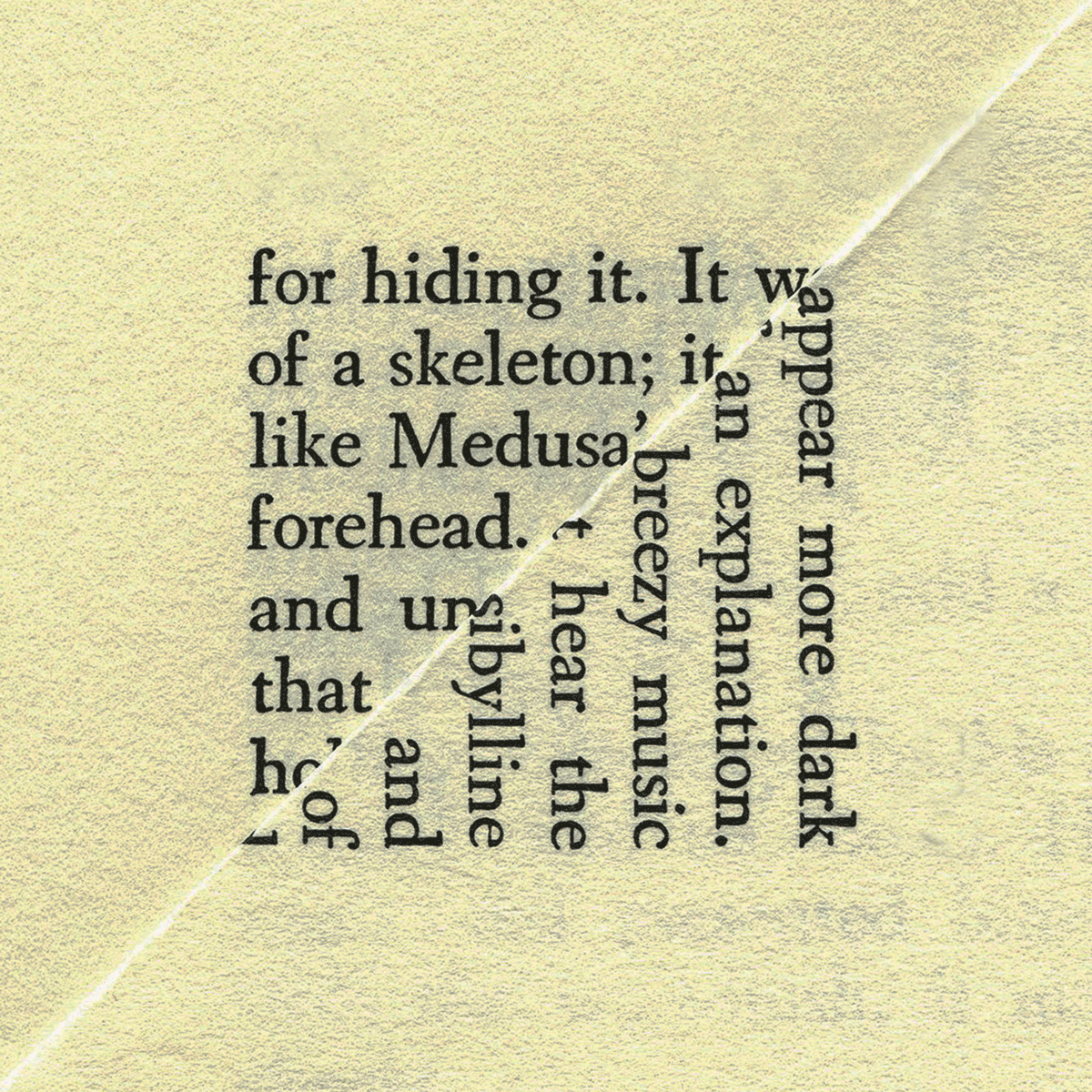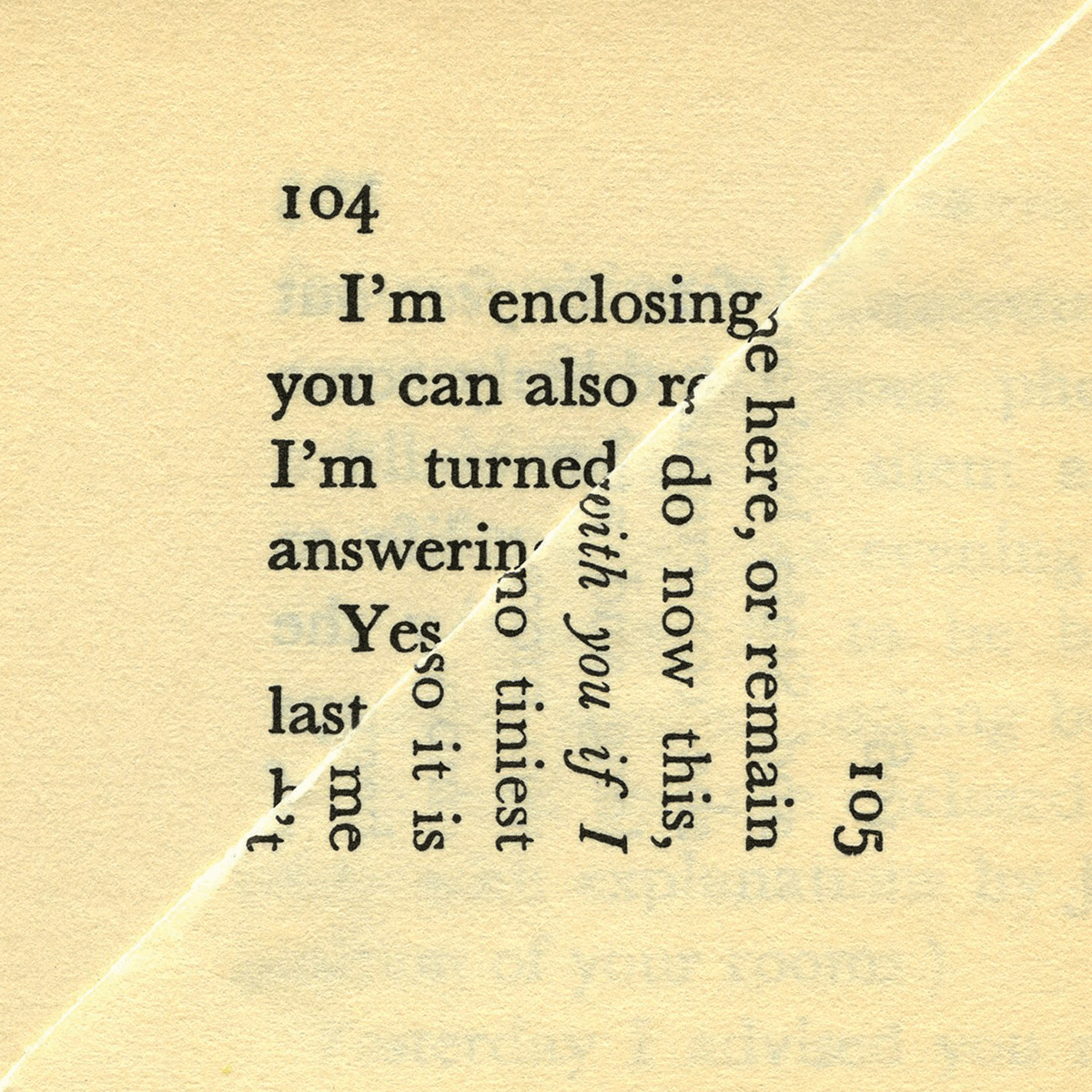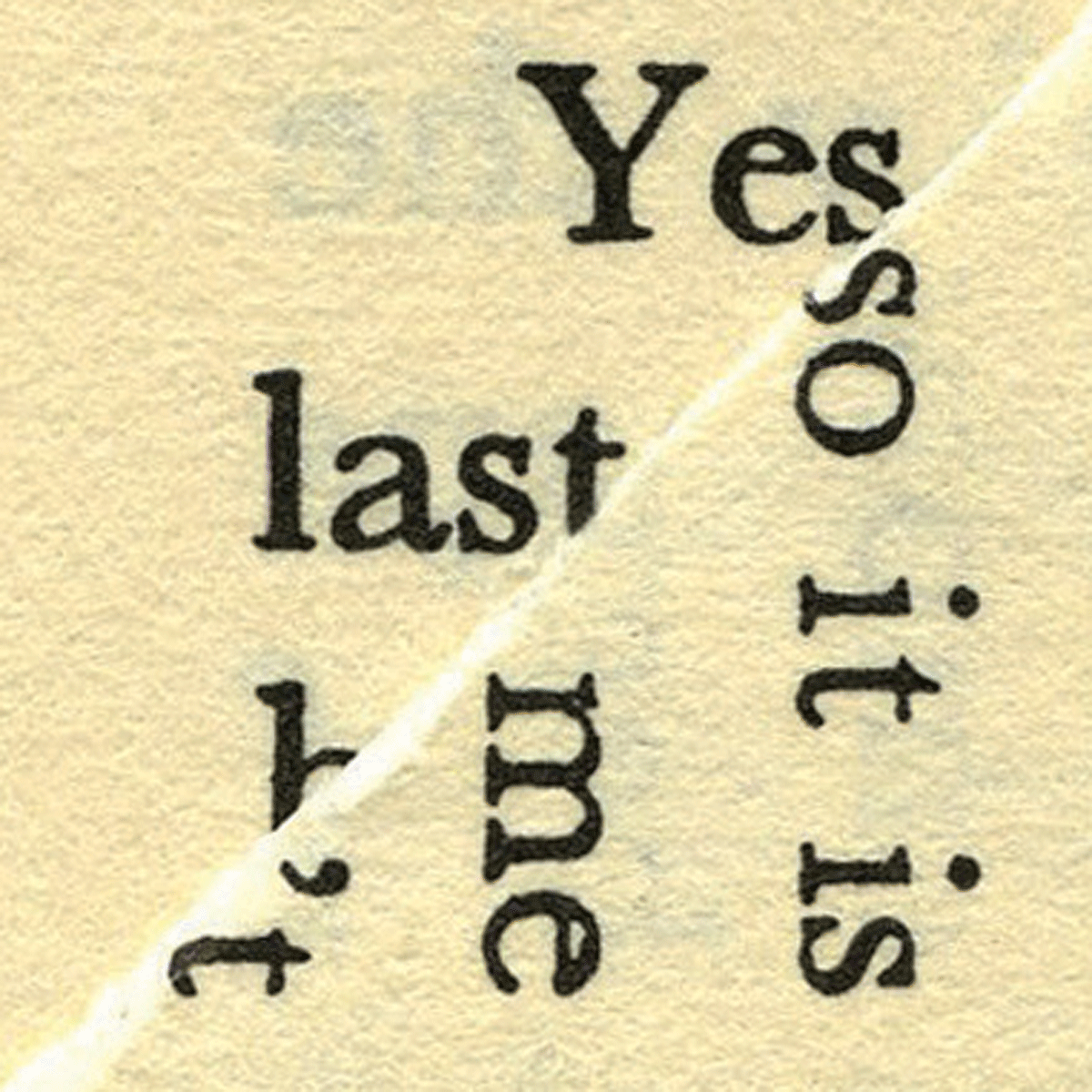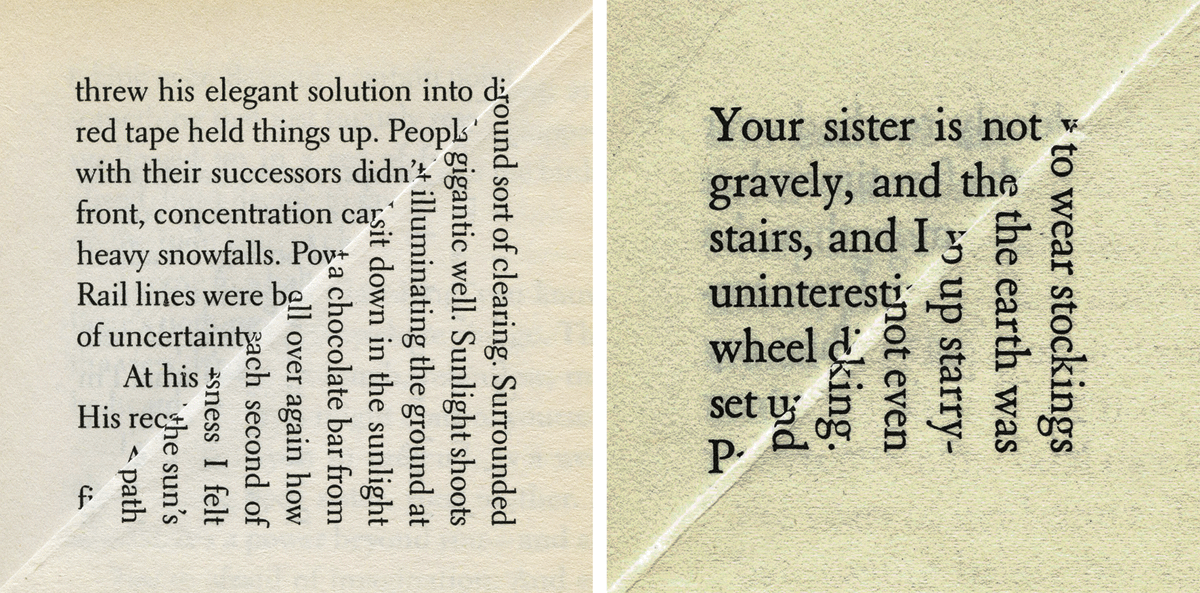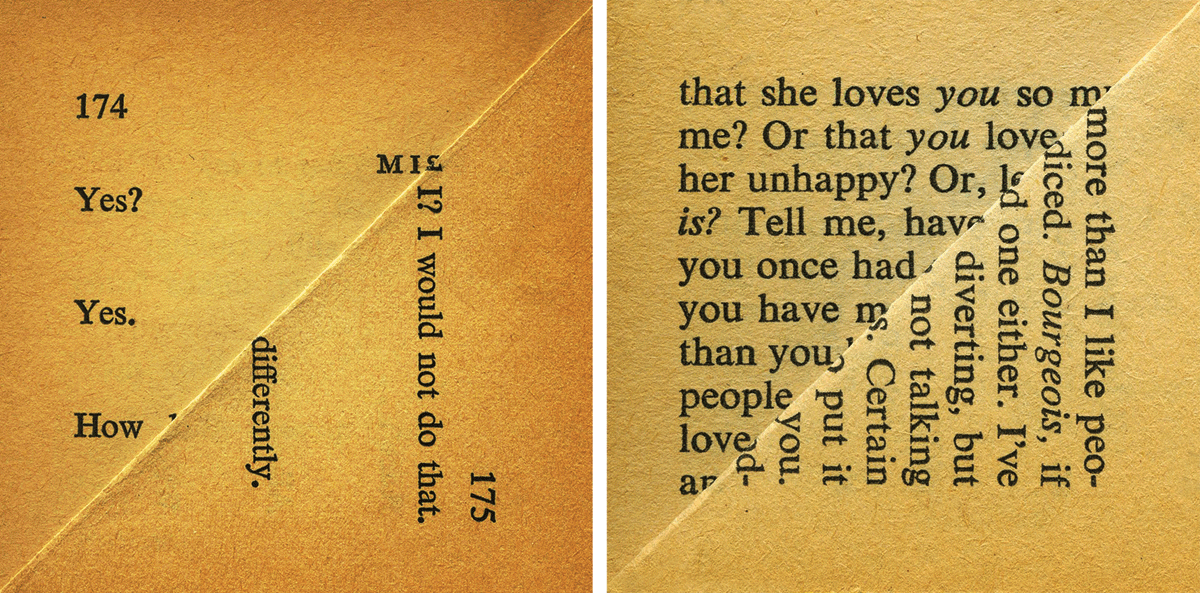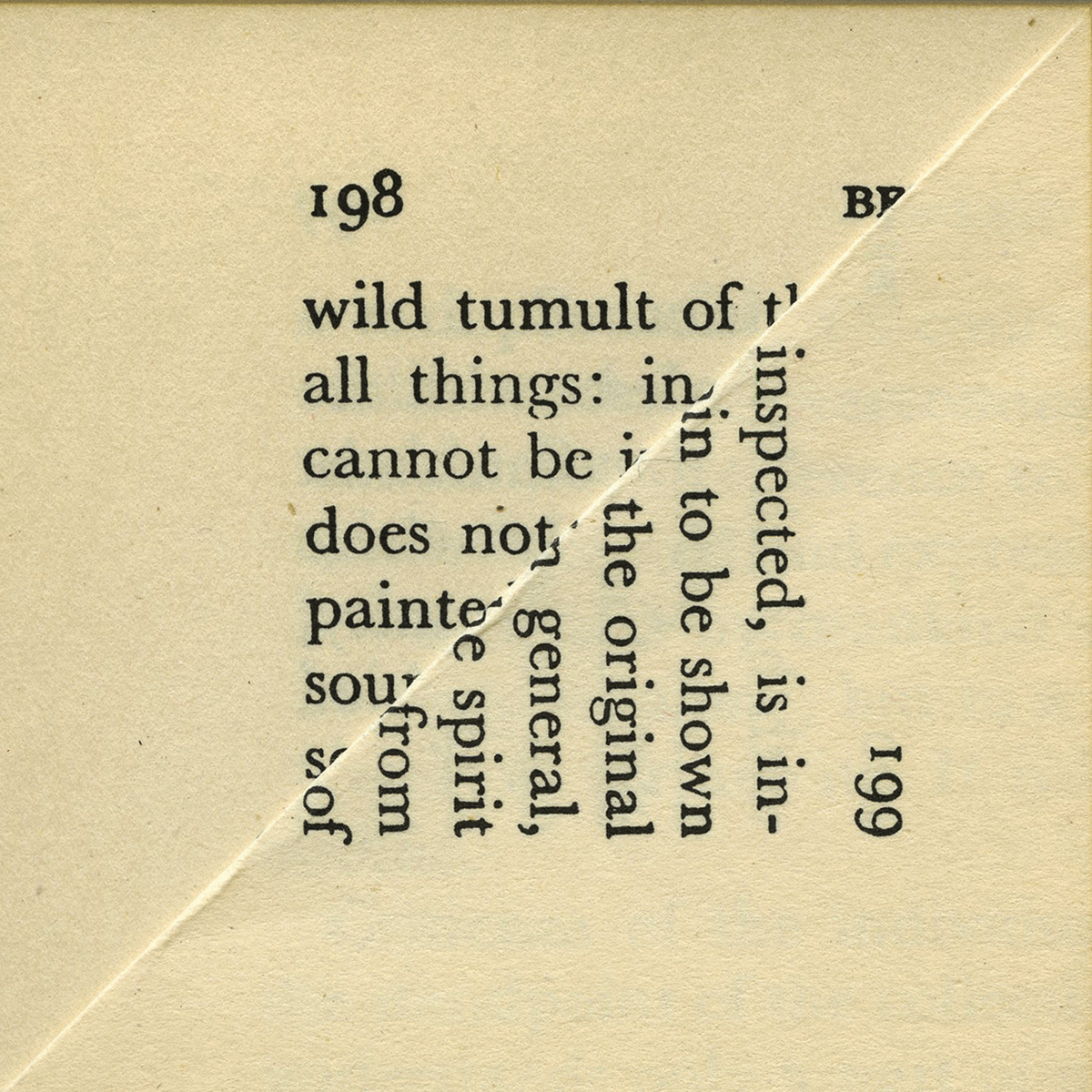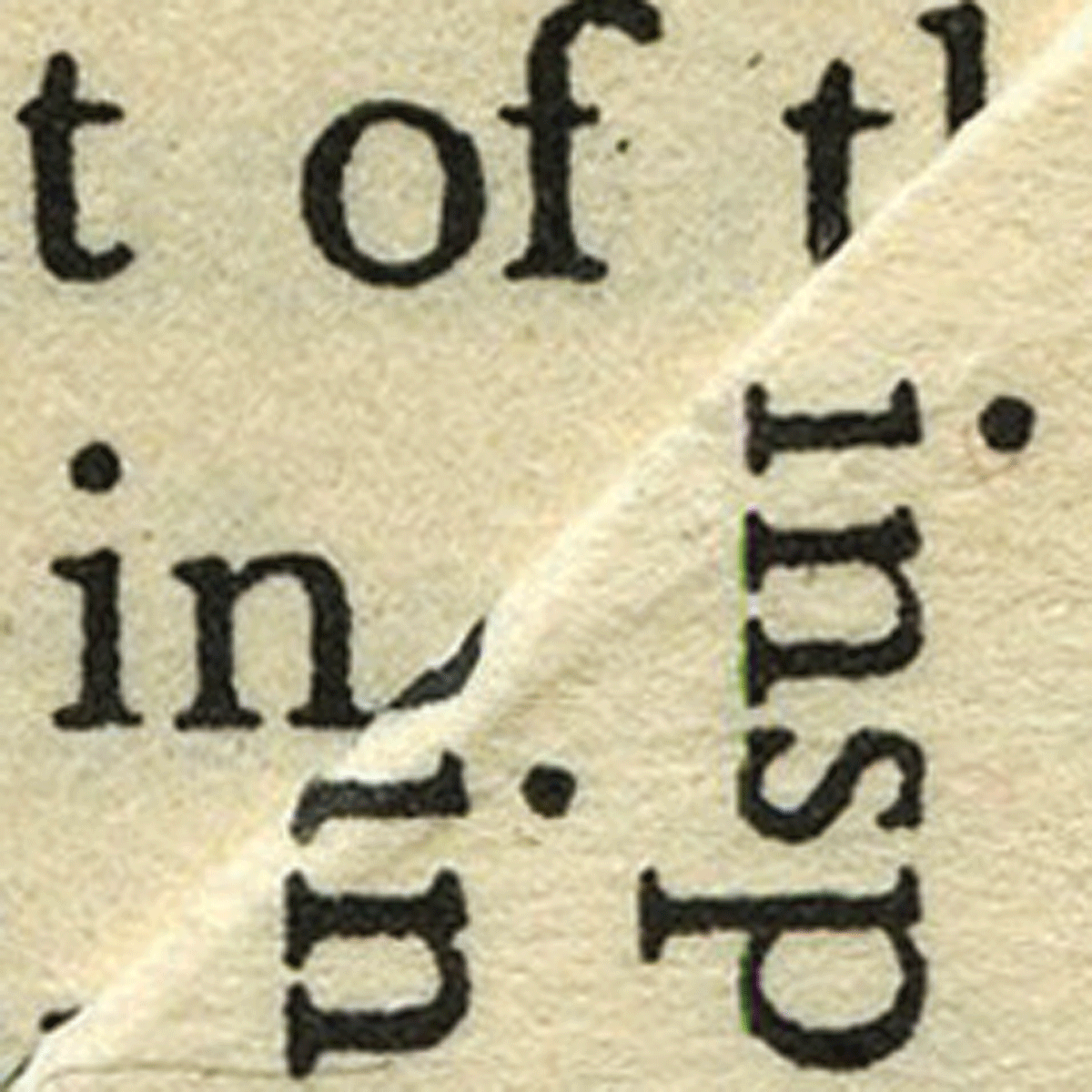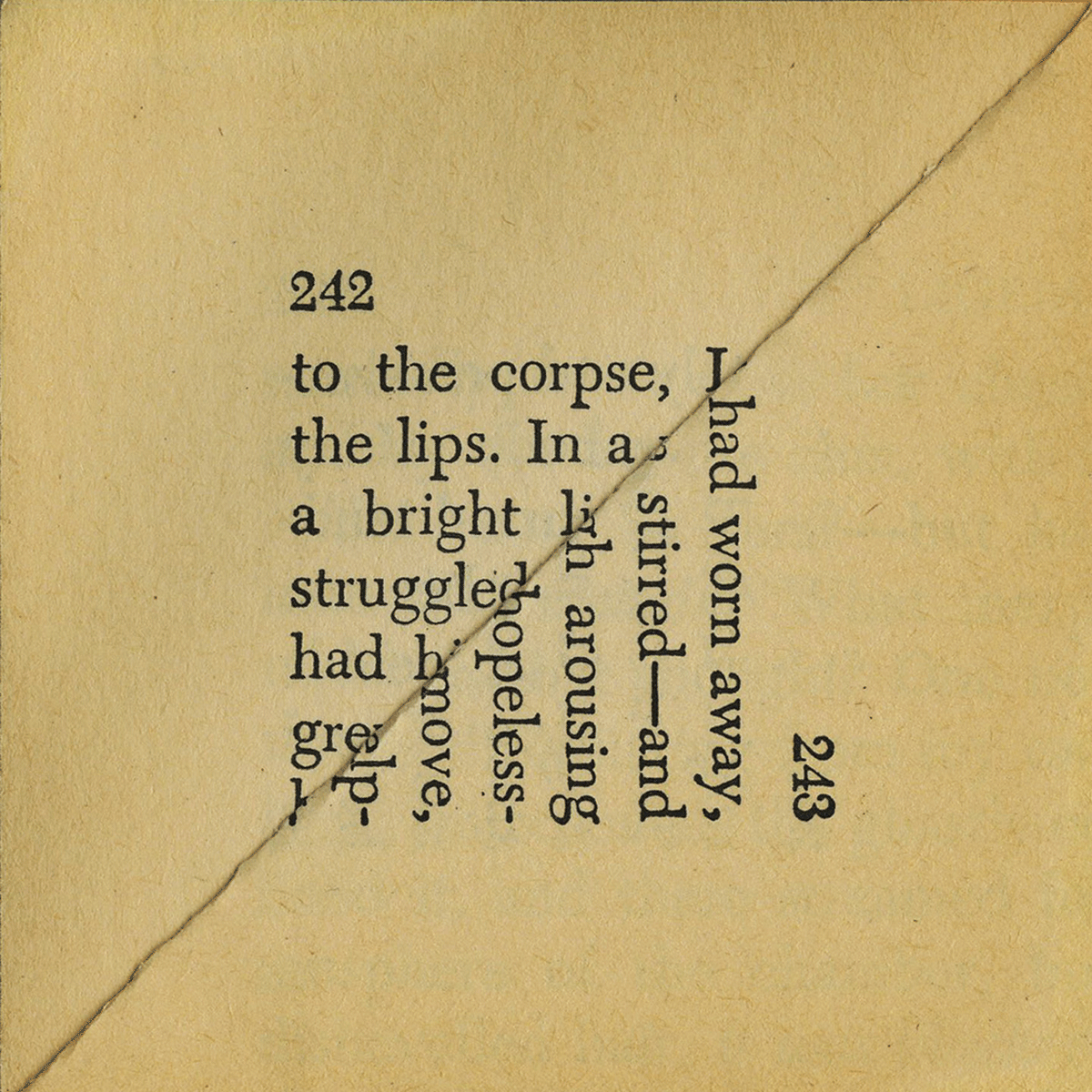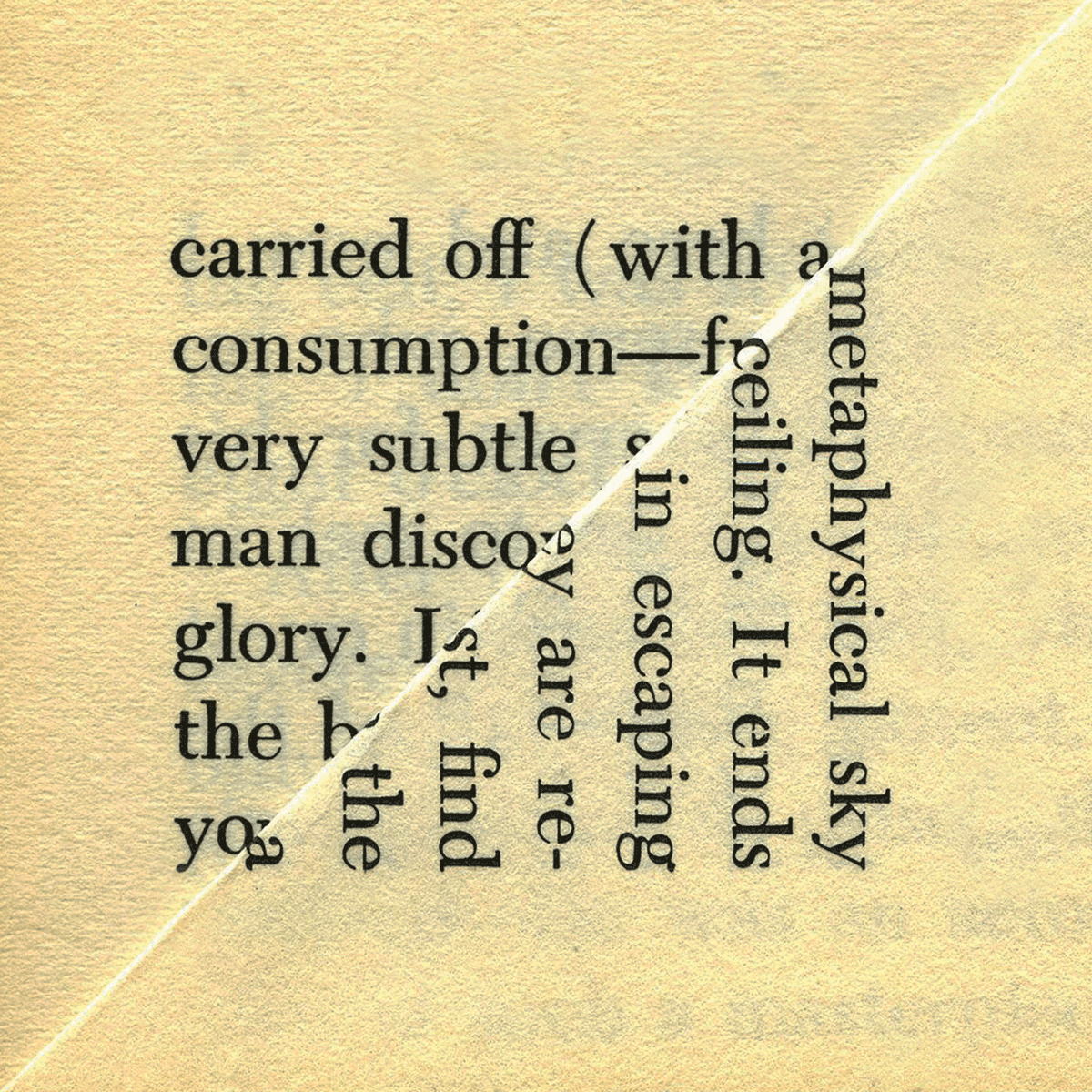How do we sense the afterlife of another reader’s attention? What sort of traces are retained in the body of a book or page that enable questions and reveries that would otherwise evade us? Marginalia may seem like an obvious answer but it is irritating as often as it is interesting, especially when it is our own. And so maybe we will find ourselves drawn to common habits that can stand in for additional script, little moments of decision that murmur: Where once I was, you are now, dear reader. The dog-eared page says this silently, then something more. A vernacular mnemonic device, it is as recognizable a human habit as the sight of someone biting their fingernails. A little bit destructive and ill-mannered, it is also consistently withholding, since it does not announce why a passage was of interest or what sort of gloss might accompany its reconsideration. The earliest example of its use cited by the OED (2nd Ed.) occurs in 1659: ‘To ruffle, dogs-ear, and contaminate by base Language and spurious censures the choicest leaves.’ Thus, dog-earing is able to illustrate how easily the most authoritative and immaculate book can be corrupted, even as the gesture itself remains distinctively minor. It is threshold work, dependent not on grasping but pinching. It concedes, in advance of moving on, that the reader is already thinking about turning back.
Erica Baum began investigating possibilities for dog-earing as an art practice over a decade ago. Documenting the results by way of a digital scanning bed, her images are printed at variously expanded sizes. Lifted from its initial context, the newly forged page of writing has incompletion riven into its structure, which depends on the (re)composition of one square of text by two orthogonal triangles (Figure 1). Her folding invites suggestibility into the surface of the page in tones and positions—disjointed, subliminal, sharpened, and evasive—that we could not have seen (or heard) before they were rearranged. These are found poems, predicated on aleatoric processes.1 Baum has described her role in their composition as ‘reauthoring the text’ (Alemani, 2010: 108) and in what follows I ask how that act of reauthoring solicits an open-ended engagement from her audience. How is our attention circumscribed by the interwoven affordances of different media to orient us to what we are reading, seeing, or sensing within or just past the page? What is the shape and sound of the alterity moving across or behind this interface of legibility, opacity, and suggestion? How do the interpenetrating roles of concealment and variability at the surface of these images sustain what I’ll be calling a poetics of gestalt?
There is a foundational distinction to be made between Dog Ear as it appears in gallery or museum settings and Dog Ear (Ugly Duckling Presse, 2011, 2016) as it exists in the form of the codex. The latter will be my primary focus in what follows. Obsolescence, or its threat, has a color and a weight that changes depending on where and how we encounter these dog-ears. While blanket declarations announcing the death of the book have come and gone, the tenuous hegemony of the printed page is part of what gets subsumed back into these meditative, elliptical intersections where an ephemeral sense of possibility is experienced as an unorthodox lyricism. Baum has sifted through outmoded information tools and carriers across multiple serial works, from card catalogs to chalkboards to scrolls for player pianos (Figure 2, 3). The results are beguiling, in part, because these are dialectical images.2 They are unsettling because we do not quite know where we are and they are historical for the same reason. Baum has a facility for drawing out the residual enchantments from these banal organizational systems because remnants of something more ineffable has been deposited into them. Whatever is being fitfully revealed is bound up with what has already disappeared or is crystalizing into elegance as it slumps into disuse.
These historical formations and attendant media maintain a set of frictions and admixtures that run throughout Dog Ear.3 However, the practical questions of encounter that each of these images circle and refigure in divergent and overlapping ways is what I’d like to continue exploring. While I want to maintain a space for thinking with and around some of the disparate genres and theoretical turnstiles that have an impact on this work, it is equally important to keep contact with the simplicity of Baum’s gesture while continuing to parse its refrain. Dog-earing is a quotidian act of desire and uncertainty. We wanted to remember something but weren’t sure that we would. So we asked the page to remember for us, or simply to tell us where we left off, once, when nothing else was at hand to mark our place.
Gesture turns the printed page into something more like landscape in Dog Ear, insofar as it instigates and assembles sites the eye wanders into and through.4 Procedurally, it is repetition with a difference: a corner comes down to reveal a corner, a square inside a square. Nothing gets revealed without something else being concealed. The additional act of memory-making (or outsourcing) that a photograph provides becomes formal rather than functional. We might be thinking of Malevich or Albers or Martin. But when we attend to these images as print or as pages, the page changes, intermixing and melding lexical and visual information into a renewable and often short-circuiting tangle of relays.5 I am interested in how these images, particularly when presented in book form, invite certain affects and maneuverings from their audience which can leave us feeling discomfited, intrigued, or suddenly and implausibly seen. It is not the text so much as the fold’s contraction of the text that captures moments of interchange that feel more esoteric or divinatory. Contingency has seen fit to speak and is speaking to ‘us’. I will be using plural pronouns as I move through these examples as a way of demonstrating how these pieces promote and refract this compulsion to make sense of a code wherein we hear ourselves being addressed.6 I should also acknowledge that any person’s experience of Baum’s work will be further inflected by their relative degree of anxiety, wistfulness, or indifference toward the printed book as a format whose relevance to the present moment is receding. This is not a claim of fact but rather a stipulation about how we might feel toward the book as a vector of meaning and as a site of imperiled authority, preciousness, sentimentality, familiarity, and beauty.7 The overlapping and contradictory associations that this form has with assuredness and an increasingly heightened precarity are clearly part of what sharpens their reception.
Before we return to the question of the remediated book, we should consider the space of the gallery, where this work first entered into the world. Two features would have stood out fairly quickly in that context. The first is that, after even a cursory glance around the room, it would be clear that this is a serial work. Second, it is relatively easy to grasp the conceit: the corner of a page has been turned down, leaving a partial view of the two pages involved, now split diagonally to make a third text. No words from the dog-eared page that faces us can be seen. Some of the visible words rattle against each other in ways that feel evocative, clever or mysterious—both fragmentary and ‘poetic’. But maybe it is the night of the opening and the room is getting more crowded. We may feel encouraged enough that we’ve seen what there is to see and contentedly or hurriedly call it a night. Alternatively, let’s say one of us stays on, standing in front of ‘Word Intention’ (Figure 4) while the people come and go.
The experience moves in phases. The inlaid, herringbone pattern of the lines allows for an interval of time to open up in which not reading become more plausible because it is pleasurable just to be looking. The arrangement feels, for a moment, like the interplay between a drawn bow and feathered arrow. But the fold pulls us back into the murky space of suggestion and the drift of code as the eye tracks the luminous white slope set against the oatmeal-colored paper. It clefts the page like a till, showing the rift where words clamored at the thought of being filled, significant, and you know, like, deep. They settle for being smashed-up and gloom-filled instead, shuffling into little recombinatory formations that surface and sink away again, plagued by being a part disassociated from any whole. This is an apprehensive sketch of what peering into this texture might sound like. Does it count as a reading?
In some of the secondary literature on Baum’s work from critics who primarily view it through the lens of concrete poetry, multiple attempts have been made to transfer the texts from her images into a more recognizably line-broken poetic format.8 Applied to ‘Word Intention’ these methods render the following result:
word, intention
At the thought
to smash up
d gloom filled
plagued b
clamoured
As
n, deep-
part
n till
s
The problem is that this process has fundamentally leveled out the ways we experience discontinuity within and between different lines of the text. Each potential pause or turn is presented as the same kind of line break, even though half of the time we actually need to describe a right-angle pivot. This interpretative approach imposes an artificial fixity on the work while erasing the variable, recirculating rhythms of the reading eye. In her 2011 review of Dog Ear, the poet and critic Amaranth Borsuk recognized this formal problem and proposed the use of a vertical bar to indicate a full line break, while reserving backslashes for these pivots. Using her approach leads to the following variation:
word, intention / At the thought | to smash up/ d gloom filled | plagued b/ clamoured | As/n, deep- | part/n till | s
While I remain agnostic as to which of these procedures more effectively clobbers the artistry of what Baum has managed to do, I think it is important to recognize that Borsuk is addressing the ways that these texts simply do not behave like standard-issue, line-broken poems.
As we stay with the problem it becomes clearer, each time we encounter it, that the choice of whether to read across the fold and maintain the line as a (bent) unit is actually an essential aspect of what makes these pieces feel alive.9 Because it feels equally ‘natural’ to read the next word or phrase that occurs along the contiguous horizontal or vertical strip, each of these choices now comes to feel more contingent. A paradox near the core of Baum’s method ensues: even as the fold re-situates a text whose readability has now been strictly demarcated, the experience of reading becomes more amoebic. Loosening the logic of line breaks and syntax simultaneously, the bounded page lets the eye rove and sift through its pieces, though this process comes to feel as though it has no direction or designated end, no front or back. Registering the consequences of those converging dynamics is part of what I will address in more detail as we go on.
A broader problem with these attempts at lineation is obvious: they are trying to lift or extract a sense of poetry from this work that is somehow distinct from its materiality. The fact that the two seem profoundly interdependent might be one reason to consider enlisting ‘Word Intention’, rather than either of the possible transcriptions on offer, as one fragment within a poetic nexus, rather than a stand-alone poem. It may be particularly useful to reapproach Dog Ear within the tradition of artists’ books more specifically, rather than as a discrete collection of photographs, in part because it allows us to begin by noticing that ‘Word Intention’ is actually not included in this book, despite being completed before its 2016 reissue. This is an informative and generative fact. Within the confines of the codex, Dog Ear doesn’t serve as a comprehensive overview of Baum’s project or even present us with the catalogue of a single exhibition.10 Instead we are conveyed through a selective sequence of images from an ongoing series within a book whose reflexivity is synonymous with its dependence on other, almost entirely unseen, books.
The codex facilitates longer, slower events of absorption by enabling its audience to linger and return outside of gallery or museum hours. The temporary or permanent possession of these printed images becomes more plausible, which enhances their ability to get a hold on us. In her indispensable scholarship on this topic, Johanna Drucker makes a foundational distinction between artists’ books and livres d’artistes:
[I]t is rare to find a livre d’artiste which interrogates the conceptual or material form of the book as part of its intention, thematic interests, or production activities. This is perhaps one of the most important distinguishing criteria of the two forms, since artists’ books are almost always self-conscious about the structures and meaning of the book as form (1994: 3–4).
Because of Baum’s widespread recognition within the art world, it is worth lingering on some complications relating to this dyad. For example, Drucker’s very next point is that a livre d’artiste will generally maintain ‘the standard distinction between image and text […] on facing pages’ (1994: 4), which is precisely the arrangement within Dog Ear (Figure 5).
But these received features of the catalogue (appreciative essays also appear at either end) offer only a modest camouflage for the way this book’s contents shift the terms of the pages we turn. As they are gathered and bound into a new set of physical relations, this finite set of contiguous digital prints makes the referentiality of any one of its pages wobble. By removing the image from the gallery setting, ‘page’—as an object, as an image, and as an idea—becomes a more indeterminate designation. It arrives and diverges from itself simultaneously. And so, while conceptual works like Sol Lewitt’s Squares with the Sides and Corners Torn Off (1974) offer up parallel strategies of effacement, later entries in Drucker’s history such as Telfer Stokes and Helen Douglas’ mesmeric Real Fiction: An Inquiry into the Bookeresque (1987) provide a more resonant precursor to Baum’s project (Figure 6). Each refracts the page as an infrastructure of coherence and ‘lay[s] bare the mechanisms of book as process. The concept of representation, through which a book comes to ‘contain’ things in the pedestrian sense, is made into a game of self-referentiality’ (Drucker, 1994: 195). While it is not contained within the covers of Dog Ear or Real Fiction, the hand that ruffles, pleats, or flips the pages into or away from our view becomes a vital carrier and afterimage invited into each work. Its phantasmatic presence makes our encounters with meaning, or its evasion, possible.
While, according to her publisher’s description, mass-market paperback books serve as the source material for these images, Baum does not include specific bibliographic information on the texts she’s appropriated.11 Consequently, any viewer intrigued by a hint of plot and curious to read beyond the snippet they can see will be out of luck. Perversely, whatever autonomy these fragments declare for themselves is dependent on their capacity to frustrate preexisting and predictable patterns of use. Their new role is one of playful restraint, allowing readerly desire to manifest in the act of being deflected and rerouted. The self-seriousness of the gridded square, with all its modernist gravitas, is here only the conditional result of a passing finger. With this adamantly analog act of digital manipulation a view opens across a matrix of sense-making whose contours reveal themselves to be as contingent as the shape of a letter. Furthermore, because our reading is consistently enticed or provoked rather than fulfilled, our interaction with any of these works will be sustained by a temptation to go beyond what is discernible, to read the unreadable, sound out the silences, and decipher what is staring back at, into, or through us.
On the wall each image is 9 × 9 inches. Subtle and drastic differences stand forth immediately across such a consistent format. Even from a distance we notice the variance in color and texture, along with the font and density of the print and the shifting size of the text-squares against their paper borders of pale peach or sand (Figure 7). As documented miniatures, these works are displayed at ten times their initial size. When they return to the codex version of Dog Ear, they will shrink by more than half: down to 4 × 4 inches, against a background of consistent white measuring 7.25 × 8.5. We might register these stylistic and affective qualities simultaneously when viewing a clutch of images arranged on one wall of a white cube, but this experience is incremental and deferred when we approach them within the body of the book. Shrunk and (re)bound, these pages take on an additional, uncanny resonance by refitting their dimensions into a disjointed echo of the mass-market paperback. The horizontal to vertical ratio of the MMPB is approximately reproduced as the 4 × 4 image mounts the platform of the nearly-square page. Each edge has been placed into a parallel set of relays between the borders of the photograph and the wider borders of the book itself. Even while this facet of the work can pass beneath the radar of our conscious attention, its nearness to these familiarities informs how we handle it and what we might think we are looking for. As Lisa Gitelman has pointed out: ‘histories of genres and histories of media don’t so much overlap as they intersect, constituting partial and mutual conditions for one another’ (2014: 10). In the case of Dog Ear, this splayed version of an MMPB offers the eye another memory of the hand, which held and was held in turn by the book like a pillow. In their rearrangements, they will continue to ask us to rethink what holding might be.
As a way of offering an extended response to Dog Ear as a book, this essay will address a significant number of works (nine of the twenty-four), in the order of their appearance. I will be more deliberate at the outset and my selections will be a little less than arbitrary, while focusing on the formal importance of the square, the corner, and synecdoche for the book as a whole (Figure 8). I’ve also chosen to mostly discard the explicit issue of lineation, not because I think questions of form are secondary but because I want to retain a certain focus on print language as it interacts with other expressive elements within these works as they warp and restructure the act of reading. To the degree that it’s possible, I’d like to stick with the trouble that Baum has started by offering us a distinctly disorienting experience of the page. This will mean suspending the issue of line breaks in order to rehearse a poetics of gestalt that mimics the fitful temporalities encased by these interventions unfolding within the reverberative space of the page.
Consider ‘Examined’ (Figure 9), the first image within the covers of Dog Ear. As the eye begins its customary route across the upper strata of the square, it finds itself being redescribed in the phrase it passes through—moves a pile—before encountering a choice. Shifting to the next line down will sacrifice syntax in order to arrive at the materi- while reading across the fold and along the vertical edge resolves this problem to a degree (moves a pile -nd examined the materi-) and brings us tantalizingly close to the satisfying click of a recognizable phrase. But are we at the kind of beginning that would seek to create a clearing or prospect (one that would attempt to get material out of the way) or is it one that moves a pile of that material front and center, to be examined? Does it matter whether we complete materi- or that we are missing the same vowel twice in this phrase, and that it happens to be the first letter of the alphabet? The outer edges of the page have already presented a puzzle and an object responsive to our choices. Moving down and into jammed ironically injects more semantic flow into the square. Like a latch or dropped-down drawbridge, it splits the past of what was and what was being examined, dangling between the edge of the crack that materi(al) has disappeared into and the nothing that follows on. Everything suddenly appears more definitive and opaque. Perhaps it is not surprising if we are feeling genuinely jammed or entrapped; but it is also possible that this work has been jammed open rather than simply gummed up, capable of curling back into the crease and quotation mark that constitute its very being, insisting on the pale hue of the passageway opening out between more and nothing.
Examined © Erica Baum was published in 2016 in Dog Ear (Ugly Duckling Presse, Brooklyn, New York).
By insisting on the productive status of gaps and sabotage from the very outset, ‘Examined’ serves as both an ars poetica and an initial offering to the activated, anxious reader in the market for rereading as a protracted seduction. We may even remain animated by an ongoing expectation that something is going to be revealed well past the point when the ability of ‘Examined’ to resolve itself into any solid meaning has fled. This is one way of viewing our desire to stay attached to a world, even one that emerges from fiction or apophenia. Something in this need is being transferred, soldered, or buttoned down into the bottom-left corner of the work, where the two most common vowels in the language have been cinched into a single rebus. Thus, the fold, as a transversal movement, offers the world back to us, now partially collapsed, but still presentable. We might not know what this glyph sounds like or indicates, but we somehow know it has not quite managed to be, even as it beckons more elegantly because of the adverbial of ly” billowing out suggestively in the preceding line.
With the appearance of ‘Spectators’ (Figure 10), our attention swells out and down, across the gauzy translucence of the paper whose inconsistency in shielding the unseen text from view pulls us closer. The lettering projects a shadow text of nearly intelligible words—mine were seems to run like a caption under those, but looking up through the vaporous strips makes any kind of possession seem indistinct. Further away we see the smudge of a pocket just under another were, and then another word ending in -ly but otherwise opaque. Returning to the comparative clarity of the surface square, we discover that reading across the fold does not produce anything as evocative as what we encountered in ‘Examined’. Instead, the submerged text inflects the crisply outlined words with a slurred, associative sense that makes spectators sounds more spectral. The grid’s interior now seems more capable of tightening and trembling in relation to this gray asemic whisper. Perhaps these are not simply pages but also screens. The overlapping etymologies of the latter term in English, alongside its equivalent in French and German, has been sketched by Gunther Kress (2006). Within this trio ‘the common source/history/genealogy of the words screen, écran, and (Bild)schirm […] across languages and cultures, meanings of defence, protection, shelter, concealment, partition dominate over that of display’ (Kress, 2006: 203). If a page displays by way of attachment (its etymology is bound up with fixity and fastening in the Latin pangere), a screen shows itself by shielding, keeping intelligibility at bay.
Spectators © Erica Baum was published in 2016 in Dog Ear (Ugly Duckling Presse, Brooklyn, New York).
We should remember that the ontology of the image in Baum’s work is always caught between these two words. These are born-digital prints and therefore instantiations of code (and screens) even as they depict the apparent source of the image on paper. Whatever tangible assurance of an origin might have clung to the photographic negative is now propositional, hazy, a spectral fiction. Which is not to say it has gone missing entirely. Since these images are also inseparable from an indexical trace that has been literalized across the cheap paper pressed into the scanner bed, it is impossible to say where effacement ends and commemoration begins. The tactility inhering to a work like ‘Spectators,’ where we can see that the severity of the fold was enough to put a thin, buckling scar into the paper, affirms W.J.T. Mitchell’s dictum that ‘all media are mixed media, and all representations are heterogenous; there are no “purely” visual or verbal arts’ (1994: 5). The visible handling of the found page is what makes the page-turned-image become a plural, porous, and radiant instance of kinetic sculpture.
Something in this radiance is dependent on the way that these halved-and-doubled pages have also concealed themselves into our view. The diffuse blur of print-as-screen drifting up and across the lower right quadrant of the image is, in fact, only clarifying how the emergence of any figure into the foreground is predicated on an instant in which ‘other things, and indeed spaces, are relegated to the background; they are only ever co-perceived.’ (Ahmed, 2006: 547). This image is a contestation of that process, even as it appears inside another bound page’s white framework, against the background of the world in which you are holding it open. Still, its effect upon the scene gives us a different way to (re)orient the world inside the square. We can move back into the interior of crisply outlined lettering by way of the lower right corner of the page, should we so choose. Something in the faint repetitions of were and were in that smoky outer wedge joins which and was as the faraway and nearby move toward one another with sudden sharpness (alto). These are shimmering but vague pieces of a song or memory you could not help, even if you know it is an artifice, like any song, a way of capturing time, rearranging moments, shuffled or enmeshed into glances. These are the instants that spectators and specters are made for and of. It is why we cannot seem to see through them or without them.
‘Mad’ (Figure 11) pushes the torsion of the page further away from what has been hidden and more deeply into what seems irrevocably lost. We know it is about loss because the voice is deliriously affirmative. The paper is an acrid mustard, glowing between gaps of printed script. It begins in repetition and italicizes its linking verb to the past. Read quite deliberately and sanely, from top left to the right, the first two lines feel like a splinter of overheard conversation. Whoever the speaker has been listening to just said something that allowed them to feel seen; the reply carries an urgency emphasizing the distance between then and now. To put it more generally: Plot stalks across the back pages of this scene, but remains mostly murk rather than action: high drama from an unpublished or untellable episode, now subsumed into the conditions of the exchange that suddenly turns toward and away from us.
Mad © Erica Baum was published in 2016 in Dog Ear (Ugly Duckling Presse, Brooklyn, New York).
It is striking that, even in describing her separate series of photographs, The Naked Eye (Figure 12), in which the dyed edges of paperback books are propped open to reveal enigmatic film stills from the sixties and seventies, Baum also speaks indirectly to the reader/viewer of Dog Ear:
I’m drawn to pictures that look as though the figure in the book is unaware of the viewer and in the middle of something, either thinking, dreaming or on the verge of an action. That sense of being in the midst of something parallels the fact that they are in the midst of a book. I don’t want to be specific about their thoughts or actions. I just want to create moods and suggest a new relationship for the figure in the book as well as for the viewer looking at the photograph of the book (Alemani, 2010: 107).
As it pertains to ‘Mad’ this lack of specificity regarding thought is rapidly overtaken by the jagged indeterminacy of recombinations that fan out beneath the first two lines. As we return to them, they continue in their disavowal, as if to insist: I am not now, as you can hear me speaking, in any way ‘mad.’ At least not like I was. When? In this picture you have only been allowed to see the outermost edge of. The canopy of the phrase at the top of the page does not hold the pieces beneath it so much as it pushes them back toward a point of impossible beginning, an impossible was. They keep starting over again as the tattered grid rattles itself into a perpetual, jittery re-ignition of frantic stuttering loops: Yes! Yes! I was mad in his thou with a doll in the couch Our car leaping with a fin in his fin I was Yes! Yes! I was MIST in his couch with a thou, the Sud in the SuM leaping Yes! leaping I was leaping in his car with The doll Yes! Yes! I was mad, ad infinitum. It is exhilarating, but in the way that referential mania is exhilarating. The page is more like a cauldron or a dissolving lattice, where any of the elements can be refitted together because nothing actually connects. Phrases are ceaselessly redistributed into shapes but evade a syntax that would allow the present to peel away from the past.
As should be clear, little to none of this lends itself to any recognizable strategy of lineation. These are not fixed, rendered figures in prose or verse but something else, appearing tempestuously at the point of contact between seeing and reading. The gestalt, in this case, does not depend upon a single figure/ground relation, but the ability of different words, scans, or glances, at different moments, to step forward and disappear without letting the page(s) shake off their echo. This also clearly applies to our experience of the photographed paper that carries its own affective charge and afterimage from one work to the next. The matte opacity of ‘Spectators’ did not turn into a gray crystal until a countervailing sense of brittle, sour heat emerged on the successive page. Moving through Dog Ear entails a perpetual (re)orientation to the screened, sculpted page as we are continually reminded of the disunion between the paper we are touching and the paper depicted on it. At times it seems like a phantasmic quality within paper itself is coming to the surface to meet our touch.12
The overdetermination of ‘Medusa’ (Figure 13) as a title is not the only reason to single this work out as another avenue for thinking about configurations of relation and fixity. It is also the ninth work in this sequence, a square number. The position of its title within the printed square is as close as we will get to its center, provided we are intent on reading a word and not a blankness. Inevitably, as we recognize the outlines of her name, the white square immediately beneath the word’s back half opens up to hold it aloft, as if to display the circumference of a severed neck. This way of reading the spacing on the page confirms a received figuration of myth.13 Another approach would begin by focusing on the paired fissures of light dilating along the crease of the page and aerating our view rather than ossifying it inside of a single look. What hems in the work at the opposite edges are the familiar anxieties: that something is hiding and as grim as the skeleton beneath any and every visible forehead. This is what an explanation does: things appear more dark as their edges are laid down. But the triangulated divot of it. It it at the top right corner of the square is, if anything, the negative image of what is at the center of things. The gap that made Medusa’s head seem to float is not, in fact, without a body. It opens in descending ribbons beneath the fold and sounds, at first, like a question or command—hear the breezy sibylline music—which is followed, if we trace the crease downward, by a second hinge of white space where we might strain to hear the sound of what connects and to and.
Medusa © Erica Baum was published in 2016 in Dog Ear (Ugly Duckling Presse, Brooklyn, New York).
‘Enclosing’ (Figure 14) marks the midpoint of the book and it behaves accordingly, as both a fulcrum and an envelope. While we hover over the heart of things, we do not know which direction they are moving in. The work itself seems to be looking backward, toward ‘Examined,’ which it resembles at a glance and in its readability, insofar as we experience a relatively cohesive flow by maintaining the pattern of reading continuously across the fold and toward the lower left corner that was established at the book’s outset. The difference is that pronouns have emerged to make us wonder what has or is still transpiring between you and I. What accompanies the promise of I’m enclosing might be a keepsake or an apartment key but we cannot see if the sender is affirming a relationship or trying to end one, using italics to show a desperation to be with you or through with you. It could be called ‘Tiniest.’ That word frames a figure-within-the-figure made up of exclusively small words in the lower left corner of the square whose sequence sounds almost straightforwardly resigned: Yes, so it is, last me—if not for the clipped b’t that looks and feels much more like a single foot jammed into the path of a closing door than but, its lexically complete equivalent, could ever manage. The slip of hurried urgency with which b’t dents ‘Enclosing’ resembles but differs from the rebus puckering the equivalent corner of ‘Examined’ because it is not dependent on a melding of letters but rather held together by a sort of granular pivoting between contraction and conjunction. As a hinge, it is another instance of holding open the refusal to choose, this time between a feeling of informal, foreshortened proximity and the broader possibility that a figure, object, action, or word might be placed into a surround, allowing other pieces of a world to move through it, making and remaking whatever it has a capacity to be. These are phenomenological phrasings of intimate questions. They have been rendered at the scale of the grapheme.
Enclosing © Erica Baum was published in 2016 in Dog Ear (Ugly Duckling Presse, Brooklyn, New York).
By contrast, ‘Elegant Solution’ (Figure 15) is cool and loquacious, with an exceptionally high word count that is constantly reaching out toward the structures of public space—those horizontal Rail lines and red tape, some shoots of sunlight illuminating the ground beneath a gigantic well. The heavy snowfalls will be a stressor for whatever infrastructure is keeping each second of from turning into all over again and it creaks audibly under the hyperactivity of these solutions and their successors writing away in anonymous offices, accumulating into a concentration that is more baroque than dramatically resolute. Though where ‘Elegant Solution’ felt urbanely ridiculous, ‘Not to Wear Stockings’ (Figure 16) seems initially simpler and harsher, stranded out in the sticks of another century. But even as the outer edges are unequivocal in their scolding (this is the only title that reads across the fold), the earth, interred like a wheel beneath this chastisement, still feels nearly synonymous with the surrounding stars and stairs as it sharpens into the farthest corner. Where Medusa’s head remained afloat, here there is tumbling, severed -d, that resolves itself into the solitary P marking the edge of the text. The proximity to the word king sitting opposite the wheel is hard to ignore, as the initial instruction, if not spoken directly by his majesty, could be in deference to the customs of the court. What it might mean to wear stockings gravely may have more to do with gravity pulling at the page’s bottom edge where the results of its acephalic logic are posited. The crease in this image is particularly thick and severe, more like a scar. Ahmed, glossing Merleau-Ponty, describes queer moments as those in which ‘the world no longer seems the right way up. Things appear on a slant. They fall obliquely.’ (Ahmed, 2006: 561). And so, again in the lower left corner of the square, we find the page poised to wobble—or to demonstrate, perhaps, that the wobble is the whole.
Elegant Solution and Not to Wear Stockings © Erica Baum were published in 2016 in Dog Ear (Ugly Duckling Presse, Brooklyn, New York).
If Dog Ear were an LP devoted to curating such queer moments, ‘Differently’ (Figure 17) would be the single. Perfect in the way that a pop song can be, it’s also more spare than a nearby work entitled ‘Spare.’ The paper is the color of sunshine. It laconically tells you everything you need to know about how to attend to these images because it seems to be doing exactly that. And on the page that follows, ‘Diverting’ (Figure 18) is also exactly that, inundated by a breathlessly chatty voice in a claustrophobic room. All of the entrapments of romantic intrigue, anxiety, sociality, in short, The Novel, are here. Unhappy? Bourgeois? Yes. Tell me, someone says, but the you that keeps getting addressed is also the one not talking or responding to this edgy set of question marks, wondering after who you love and who loves you.
Differently and Diverting © Erica Baum were published in 2016 in Dog Ear (Ugly Duckling Presse, Brooklyn, New York).
While the title ‘Wild Tumult’ (Figure 19) would seem to indicate more of the same, the washed-out gray paper clues us into something slower and more painterly about the view. There is no I or you, no me or us to fuss about. Instead we have in being repeated three times in a stutter-step near the top right seam and then again for good measure at the bottom right edge. Whatever spirit is in or of or from, its function within this schema is as a vertical prop. Whether it is imagined to be original or general or even able to be shown remains a conjecture held upright by the page but also between the pages and their blinking folds as they show forth and conceal themselves. A clear request from the lower panel of the fold—to be shown the original—is mirrored by the facing rejoinder that all things cannot be, even as the additional in that disrupts the syntactic sense of its allotted side also seems to serve as an anchor of mimetic reflection. In is a linchpin. It is also a bevel, demonstratively affirming the non-original multiplicity of any in, which includes those attached to hyphens, at the front of inspected, or the heart of ‘Examined’. Each in renews itself with the sinking specificity of a fractal. The remediated pages surrounding this commonplace preposition, newly visible in its scattering, sound out a low muffled chorus, as each fold in each anonymized page in each photograph in every part of the codex that holds it is allowed to flicker. For the reader, this enfolding and unfolding lightens and lightly dissolves any in where we might find ourselves lost, bewildered, forgetting or forgotten. It remains on the border of a spiritual position. It is one rooted in the materiality of words, made manifest and available to damage as they are pulled back through the looking glass of mechanical reproduction, brushing the auratic even as they are being ground down to their ligaments.
Wild Tumult © Erica Baum was published in 2016 in Dog Ear (Ugly Duckling Presse, Brooklyn, New York).
Confronting the emaciated lettering of ‘Corpse,’ (Figure 20) which appears to have been printed on a brown paper bag, we notice some vague gothic allure playing across the diagonal, as bright and arousing eye one another. But the only clear image is of a body with its lips worn away. Each verb that pushes against the torpor of the title (stirred or move or struggle) makes this feel more distinctly like Frankenstein. We are also half-remembering the way we came in, where ‘Examined’ is now revealing itself as perhaps only another view of the nearly inert body becoming mere material. We get the sense of looking into a casket or fresh grave (moves a pile) whose clean, sharp edges have been defined by an infill of words.
Corpse © Erica Baum was published in 2016 in Dog Ear (Ugly Duckling Presse, Brooklyn, New York).
In the wake of this dimness, the book’s final countervailing tilt into ‘Metaphysical Sky’ (Figure 21) feels elemental. It marries off many of the book’s tones and themes into paradox. The playful straining lyricism of the title (how does one distinguish the physical sky from its metaphysical counterpart, we might wonder) bring us back to a materiality infused with buoyancy. The potentially bland, conservative pair of terms surrounding very subtle—consumption and glory—are undercut and activated by man disco. The gloom of it ends is easily amended to it ends by escaping. Whether back into or out of the book is an open question.
Metaphysical Sky © Erica Baum was published in 2016 in Dog Ear (Ugly Duckling Presse, Brooklyn, New York).
While her series resists the possibility of reading for plot that her source material was built to facilitate, the elliptical interiority of Baum’s codex continues to recirculate tropes, tones, and melodramatic action that remains almost entirely off-stage. But the stratagems that enable what Janice Radway in her study of romance fiction termed ‘compensatory literature’ (1984: 95) are not simply discarded or otherwise alchemized because Dog Ear is not a strictly recuperative work, gleaning rarefied culture from low origins. To see it as such would be to misrecognize the poetics of materiality Baum deploys. The pulpy aroma that emanates across this series is inseparable from its artistry in handling love, sentimentality, intrigue, and rage at the pressure points where they appear most inchoate. Its compensations are tangible, but ambivalent, hovering between the pleasures of frustration and the satisfaction of formal closure. Living between media, these pages are tethered to one another less by systems of narrative investment and payoff and more through an extended mode of queer chiasmus.14 Rather than straightforward reversals and completions of poetic figuration, they propose modes of bending, buckling, conjoining, and peeling away instances of meaning that remain open to crystalization and evaporation. The mobility and permeability of phrases and cross-talk that each work in the book holds within itself gets amplified into a more elaborate kind of origami as each page presses into the next.
Throughout Dog Ear, the redistribution of edges entails a multiplication of thresholds. The figured phrases congealing into sense are incidental and contingent, which is to say, a semblance of any mortal reader. Being oriented to their tilted horizon is a way of keeping company with what is always off-balance in desire, as it leans or swerves toward whatever is at the edge of perception, articulation, or memory. This is a practice we disappear into and emerge from almost simultaneously. The hand we cannot see, the thumb and forefinger pulling down and pressing, proposes a life of reading as a life of rereading. If Baum has reauthored a book of nested suggestions, its silences allow us to discern both more and less than we can ever know about the alterity that informs our imaginings of how things did, will, or should turn out. As beings endowed with phantasy, the recursive trajectories of arriving and returning intermingle in the scene of reading. We act upon it and are reacted to, in time. In advance of sense, there is an interval of open possibilities: ‘Waiting is waiting for composition to happen’ (Berlant and Stewart 2019: 65).
Consider again how ‘Medusa’ invites the eye to swivel from the absent platform beneath her name across a downward slant, where it eventually encounters advertising for prophecy. A sibylline music is what keeps insinuating itself as we pursue or let ourselves be pursued by these figures. Because it recurs in the interstices between legible codes of different media, this sonority is always interlaced with static. The seismic gaps between handwork, print, photomechanical, and digital reproduction are not synthesized within this iteration of the codex but permitted, instead, a conversation that can be viewed in slivers. Even though Perseus and his mirror are unnamed in this series, there is something of his strategy being applied to the Gorgon’s stare in each of our heads. The enticing, vertiginous quality that extends across the circuitry of these works means that it is always difficult to tell whether we are sliding away from or falling into the closed, mineralizing space of self-referentiality. It is not the camera’s click but the scanning bed that acts as a blade, just as the book becomes a sack for safekeeping. If waiting and theft are the preconditions for the composition of these pages, perhaps they are also less like squares and more like spheres. Or pinwheels. They move and move us in directions we did not see by showing us something we did not know we were looking for.
Notes
- In a 2008 interview, Baum responded to the question of whether she considered herself a poet as follows: ‘I do consider this work poetry — a combination of concrete poetry, found poetry and photography. The origins of my interest in language stem from many sources. I’ve studied linguistics and Japanese language and poetry and taught English as a Second Language, all of which bring a distanced view of language, reencountering the familiar to the point where it appears strange and becomes more objectlike. I’m an obsessive reader and have a love of words in general. Many influential contemporary artists like Ed Ruscha, Lawrence Weiner and Joseph Kosuth work with language with differing sensibilities, but the starting point for my approach has its origins in the tradition of straight street photography, looking at the work of Walker Evans, Atget, Brassaï, and other artists who punctuated their landscapes with strands of found text. The whole concept of the aleatory is intrinsic to this type of photography. You work with what you find’ (Sparks, 2008: 10). [^]
- ‘In the dialectical image, what has been within a particular epoch is always, simultaneously, “what has been from time immemorial.” As such, however, it is manifest, on each occasion, only to a quite specific epoch — namely the one in which humanity, rubbing its eyes, recognizes this particular dream image as such’ (Benjamin, 1999: 464). [^]
- My approach in this essay has been to consider these qualities as constitutive and unreconciled tensions within this ongoing series while placing a particular emphasis on the productive contradictions that come to the surface when Dog Ear takes the form of a codex. However, it is not difficult to imagine a framework that considers Baum’s digital photographs through a media ecology lens with a distinctly agonistic and Darwinian emphasis, as has been articulated by Julian Murphet, who asks: ‘May we not say that on every occasion where one medium incorporates or represents another, the ecological function of this represented representation will be to secure the interests of the medium in which it takes place, at whatever cost to its incorporated rival?’ (2009: 24). Perhaps we should. But even within this model Baum’s additional act of remediation threatens to bring the contest to a standstill, precisely because it is no longer possible to say whether we are looking at the photograph of a page, or a page with a photograph on it, or both. [^]
- Parameswaran (2020) pinpoints this dimension of the work in his recent interview with Baum: ‘That little bend in the paper feels palpable and three-dimensional and almost monumental in the way the fold dramatically cuts across the landscape of the page. It plays with perception and sense of scale.’ [^]
- On the role of typeface and color in this work see King (2012). For an overview of Baum’s approach to language as an object, see Trotman (2014). [^]
- I am conscious here of Rosalind Krauss’ caution regarding the grid’s ‘mythic power […] that makes us able to think we are dealing with materialism (or sometimes science, or logic) while at the same time it provides us with a release into belief (or illusion or fiction)’ (1985: 12). However, because the material imagery of Dog Ear announces itself as fiction and also because the staging of these findings remains both an act of selection and one of sortes, this delineation fails to hold. Baum’s deliberation does not banish happenstance but rather redrafts it. A more procedural and inclusive project (one where the hundredth page of every book the artist owns is dog-eared and documented, for example) would make for a different kind of field work regarding text and indeterminacy. Baum’s hunting goes in search of something closer to the revelation of a lyric poem but its medium is intent on proving that these are things that have happened. Chance is enlisted and arranged into the lens and lozenge of the page-as-fold-as-image. In this respect, hermeticism is as important as revelation. Each image, unto itself is ambivalent. It is the willingness or willfulness of the audience to ‘see’ something in it that matters. [^]
- ‘[W]e cannot think about our electronic future without contending with its antecedent, the bookish past. Books got there first. Books and screens are now bound up with one another, whether we like it or not. Only in patiently working our way through this entanglement will we be able to understand how new technologies will, or will not, change how we read. I can imagine a world without books. I cannot imagine one without reading’ (Piper, 2012: ix). [^]
- Sparks (2011) and Goldsmith (2011) both employ the method of lineation reproduced here. [^]
- Zanghi (2016) also acknowledges this issue by re-sequencing two versions of ‘Examined’ as a means of illustrating how either pattern would read, were it maintained throughout the work. [^]
- A portfolio of recent additions to the series can be found at Posit: A Journal of Literature and Art: https://positjournal.com/2020/09/18/erica-baum/. [^]
- ‘The concept of Dog Ear is simple and straightforward: dog-eared pages of mass-market paperbacks are photographed to isolate the small diagonally bisected squares or rectangles of text.’ Ugly Duckling Presse, https://uglyducklingpresse.org/publications/dog-ear/. [^]
- For more on the role of paper in Dog Ear see Rowe (2012). [^]
- For an adjacent reading of Percy Shelley’s ‘On the Medusa of Leonardo Da Vinci in the Florentine Gallery’ as the ‘primal scene’ of ekphrastic poetry, see Mitchell (1994: 171–176). [^]
- I take the former term in the broad sense proposed by Eve Sedgwick: ‘That’s one of the things that “queer” can refer to: the open mesh of possibilities, gaps, overlaps, dissonances and resonances, lapses and excesses of meaning when the constituent elements of anyone’s gender, of anyone’s sexuality aren’t made (or can’t be made) to signify monolithically’ (1993: 8). [^]
Competing Interests
The author has no competing interests to declare.
References
Ahmed, S 2006 Orientations: toward a queer phenomenology. GLQ, 12(4): 543–574. DOI: http://doi.org/10.1215/10642684-2006-002
Alemani, C 2010 Dog ear poems. Mousse. February–March. 106–110.
Baum, E 2016 Dog ear. 2nd ed. Brooklyn, New York: Ugly Duckling Presse.
Benjamin, W 1999 The arcades project. Cambridge, MA: Belknap Press of Harvard University.
Berlant, L and Stewart, K 2019 The hundreds. Durham, NC: Duke University Press. DOI: http://doi.org/10.1515/9781478003335
Borsuk, A 2011 Dog ear by Erica Baum. Lana Turner: A Journal of Poetry and Opinion, 4(1): 282–284
Drucker, J 1994 The century of artists’ books. New York: Granary Books.
Gitelman, L 2014 Paper knowledge: toward a media history of documents. Durham, NC: Duke University Press. DOI: http://doi.org/10.2307/j.ctv11smg09
Goldsmith, K 2011 Wish me well and I’ll love you still: the dog ears of Erica Baum. In: Baum, E 2016 Dog ear. 2nd Ed. Brooklyn, New York: Ugly Duckling Presse. pp. 5–12.
King, A 2012 Diagonal semantics and the lacine: on Erica Baum’s dog ear. KR online. 10 December 2012. https://kenyonreview.org/2012/12/diagonal-semantics-and-the-lacine-on-erica-baums-dog-ear/ [Last Accessed 7 September 2021].
Krauss, R 1985 The originality of the avant-garde and other modernist myths. Cambridge, MA: The MIT Press.
Kress, G 2006 ‘Screen’ metaphors of display, partition, concealment and defence. Visual Communication, 5(2): 199–204. DOI: http://doi.org/10.1177/1470357206065335
Mitchell, W 1994 Picture theory. Chicago: University of Chicago Press.
Murphet, J 2009 Multimedia modernism: literature and the Anglo-American avant-garde. Cambridge, UK: University of Cambridge Press.
Oxford English Dictionary. 1989 Oxford, UK: Oxford University Press.
Parameswaran, R 2020 Erica Baum. Bomb Magazine. 153(1). https://bombmagazine.org/articles/erica-baum-1/ [Last Accessed September 20, 2021].
Piper, A 2012 Book was there: reading in electronic times. Chicago: University of Chicago Press. DOI: http://doi.org/10.7208/chicago/9780226922898.001.0001
Radway, J 1984 Reading the romance: women, patriarchy, and popular literature. Chapel Hill, NC: The University of North Carolina Press.
Rowe, S 2012 Fantasies of contact: Erica Baum, Susan Howe, and the poetics of paper. Full Stop. https://www.full-stop.net/2012/06/27/features/essays/sam/ fantasies-of-contact-erica-baum-susan-howe-and-the-poetics-of-paper/ [Last Accessed October 4, 2021].
Sedgwick, E 1993 Tendencies. Durham, NC: Duke University Press.
Sparks, K 2008 Assembly lines: a discussion with Erica Baum. In: Roll Playing. http://writing.upenn.edu/wh/involved/series/art/baum/baum_catalogue.pdf. [Last Accessed on September 28, 2021].
Sparks, K 2011 In moveme/braces: Erica Baum’s ‘dog ear.’ Jacket2. https://jacket2.org/article/sutured-text. [Last accessed on July 22, 2021].
Stokes, T and Douglas, H 1987 Real Fiction: An Inquiry into the Bookeresque. Rochester, NY and Deuchar Mill, Yarrow, Scotland: VSW Press and Weproductions.
Trotman, N 2014 Erica Baum: wordplay. Aperture. 217(1): 73–79.
Zanghi, A 2016 Erica Baum, dog ear. The Collagist. 85(1) http://thecollagist.com/the-collagist/2016/8/4/dog-ear-by-erica-baum-ugly-duckling.html [Last accessed on September 20, 2021].
